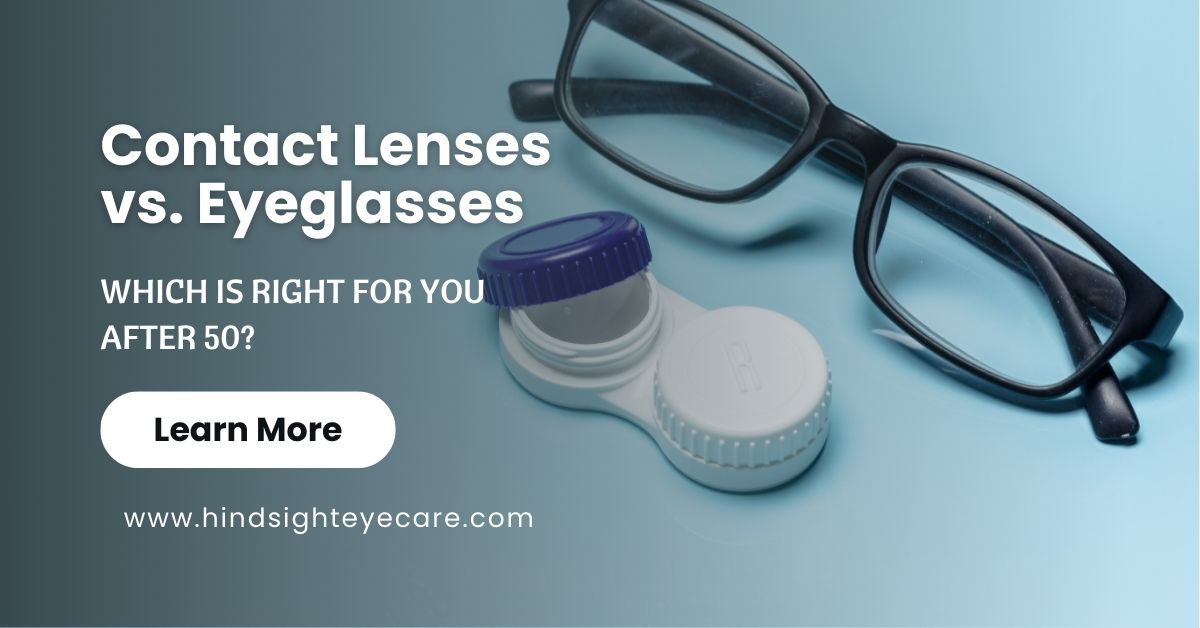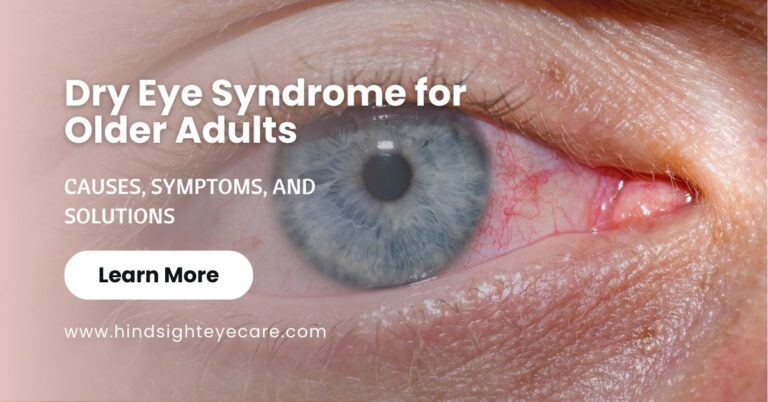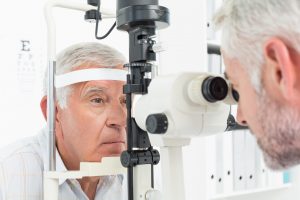Contact Lenses vs. Eyeglasses
As we age, our vision needs to change, especially after turning 50. At Hindsight Eye Care in The Villages, Florida, we understand that choosing between contact lenses and eyeglasses can be a complex decision for our mature patients. Let’s explore which option might be best suited for your lifestyle and needs.
Before we compare contact lenses and eyeglasses, it’s important to understand how our eyes change as we age. After 50, many adults experience:
- Presbyopia: A natural aging process that affects the eye’s ability to focus on close objects.
- Increased risk of dry eye: Our eyes produce fewer tears as we age, leading to potential discomfort.
- Higher susceptibility to certain eye conditions: Such as cataracts, glaucoma, and age-related macular degeneration.
These changes can influence your choice between contacts and glasses, making regular eye exams with your optometrist crucial for maintaining optimal vision health.
The Pros and Cons of Contact Lenses After 50
Advantages of Contact Lenses:
- Improved peripheral vision
- No fogging or rain spots
- Cosmetic appeal
- Versatility for an active lifestyle
- Multifocal options available
Disadvantages of Contact Lenses:
- Increased risk of eye infections
- Potential for dry eye discomfort
- Requires dexterity for insertion and removal
The Benefits and Drawbacks of Eyeglasses After 50
Advantages of Eyeglasses:
- Easy to use and maintain
- Can be a fashion statement
- Blue light protection options
- No risk of eye infections
- Multifocal options available
Disadvantages of Eyeglasses:
- Peripheral vision limitations
- Weather-related issues (fogging, rain spots)
- Potential for breakage or loss
Comparison Table: Contact Lenses vs. Eyeglasses
| Factor | Contact Lenses | Eyeglasses |
| Peripheral Vision | Better | Limited by frames |
| Maintenance | Daily cleaning required | Simple cleaning with cloth |
| Weather Effects | Not affected | Can fog or get water spots |
| Risk of Eye Infections | Higher | Lower |
| Cosmetic Impact | Less noticeable | Can be a fashion accessory |
| Multifocal Options | Available | Available |
| Replacement Frequency | Regular (daily to monthly) | Less frequent |
| Suitability for Sports | Generally better | May require sports goggles |
Factors to Consider When Making Your Decision
- Lifestyle: Consider your daily activities and hobbies.
- Eye Health: Discuss existing eye conditions with your optometrist.
- Comfort: Some prefer glasses, others contacts.
- Convenience: How each option fits into your daily routine.
- Cost: Factor in long-term costs, including replacements and care products.
The Importance of Regular Eye Exams
Regardless of your choice, regular eye exams are crucial after 50. At Hindsight Eye Care, our experienced optometrists use state-of-the-art technology to assess your eye health and vision needs.
The Best of Both Worlds: Why Not Both?
Many of our patients at Hindsight Eye Care find that using both contacts and glasses offers the most flexibility. You might prefer contacts for your golf game or evening out with friends, but opt for glasses when reading or working on the computer. Having both options allows you to choose based on your activities and comfort level each day.
Cost Comparison: Contact Lenses vs. Eyeglasses
| Item | Estimated Annual Cost |
| Daily Disposable Contact Lenses | $500 – $700 |
| Monthly Disposable Contact Lenses | $200 – $300 |
| Basic Eyeglasses | $200 – $300 |
| Designer Eyeglasses | $300 – $500+ |
| Contact Lens Solutions and Cases | $150 – $200 |
Note: These are approximate costs and may vary based on prescription, brand, and specific needs.
The final words!
The decision between contact lenses and eyeglasses after 50 is personal. Both options have their advantages and potential drawbacks. The key is to make an informed decision based on your lifestyle, eye health, and personal preferences.
We invite you to schedule an eye exam with one of our skilled optometrists at Hindsight Eye Care. We’ll conduct a thorough eye health assessment, discuss your vision needs and preferences, and help you determine the best choice for you.
FAQs About Contact Lenses vs. Eyeglasses
Are Contacts Cheaper or More Expensive Than Glasses?
The cost comparison between contacts and glasses isn’t always straightforward, especially for those over 50. Here’s a breakdown:
- Initial Cost: Glasses typically have a higher upfront cost, but last longer.
- Long-term Cost: Contacts often cost more over time due to regular replacements and cleaning solutions.
- Insurance Coverage: Vision insurance may cover both, but coverage can vary.
- Prescription Changes: As we age, our prescriptions may change more frequently, potentially increasing costs for both options.
For our patients at Hindsight Eye Care, we’ve found that the average annual cost for glasses ranges from $200-$500, while contact lenses can cost $300-$700 per year, depending on the type and frequency of replacement.
Which Is Better for Computer Use: Contact Lenses or Glasses?
For many of our patients over 50 who spend significant time on computers, this is a crucial question. Both options have their merits:
Glasses:
- Can be equipped with anti-glare coatings to reduce eye strain
- Blue light filtering lenses available to protect against digital eye strain
- Multifocal or computer-specific lenses can be tailored for screen viewing distances
Contact Lenses:
- Provide a wider field of view without frame obstruction
- Can be combined with computer glasses for optimal comfort
For computer use, many of our patients at Hindsight Eye Care prefer glasses, especially those with progressive or computer-specific lenses. These can be optimized for the distance between your eyes and the screen, reducing neck strain from tilting your head to find the right focal point.
Is Your Contact Prescription the Same as Your Eyeglasses Prescription?
No, your contact lens prescription is not the same as your glasses prescription. Here’s why:
- Positioning: Contacts sit directly on your eye, while glasses sit about 12mm away. This distance affects the power needed for correction.
- Lens Type: Contact lenses are curved to fit your eye, requiring different measurements.
- Additional Measurements: Contact prescriptions include details like base curve and diameter, which aren’t needed for glasses.
For our patients over 50 at Hindsight Eye Care, we often need to account for presbyopia when prescribing contacts or glasses. This might mean multifocal contacts or progressive lenses in glasses, each requiring a unique prescription.
Is It Better to Wear Glasses or Contacts?
The choice between glasses and contacts is highly personal, especially for our patients over 50 in The Villages. Here are some factors to consider:
Glasses:
- Low maintenance
- No risk of eye infections
- Can protect eyes from environmental factors
- May be more comfortable for those with dry eyes
Contacts:
- Provide a wider field of vision
- Don’t interfere with sports or outdoor activities
- Not affected by weather conditions
- Can enhance natural appearance
Learn more here: Dry Eye Syndrome for Older Adults: Causes, Symptoms, and Solutions




